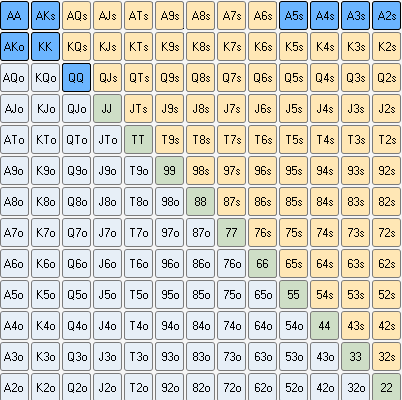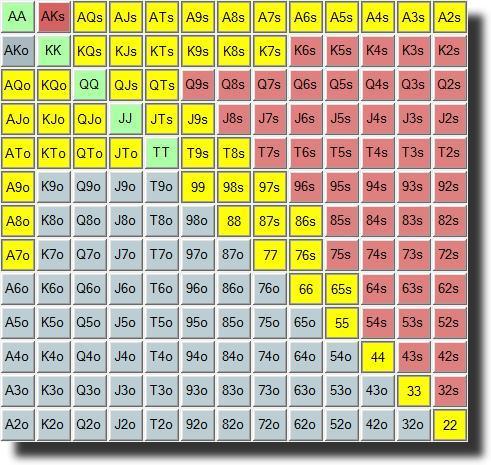Texas Holdem 3 Bet

The following Texas Holdem odds table highlights some common probabilities that you may encounter in Hold'em. It is not vital that you learn these probabilities, but it is useful to be aware of the chances of certain situations arising.
Texas Hold'em odds chart.
| Situation | Percentage Odds | Ratio Odds |
|---|---|---|
| Preflop Probabilities: | ||
| Dealt AA. | 0.45% | 220 to 1 |
| Dealt AK. | 1.2% | 82 to 1 |
| Dealt AKs. | 0.3% | 331 to 1 |
| Dealt 72o. | 0.9% | 109 to 1 |
| Being dealt AA vs. KK (heads up). | 0.004% | 22,559 to 1 |
| Dealt a pocket pair. | 6% | 16 to 1 |
| Dealt suited connectors. | 4% | 24 to 1 |
| Flop Probabilities: | ||
| Flopping a pair. | 32.4% | 2.2 to 1 |
| Flopping a set (with pockets). | 11.8% | 7.5 to 1 |
| Paired Board: | ||
| 2 players, probability of trips. | 17% | 4.8 to 1 |
| 3 players, probability of trips. | 26% | 3 to 1 |
| 4 players, probability of trips. | 34% | 2 to 1 |
| 5 players, probability of trips. | 43% | 1.4 to 1 |
How to use Texas Hold'em odds.
The odds in this Texas Hold'em odds table are unlikely to directly help your overall strategy, but they are pretty interesting nonetheless. The Texas Hold'em odds for each of the different situations have been given in both percentage and ratio odds, so use whichever format you feel comfortable with.
This opens the door for players to make moves known as 3-betting and 4-betting, which play a very important part in proper No Limit Hold’em strategy. What exactly is a 3-bet and a 4-bet? For those who are new to the game, a 3-bet usually refers to when one player raises another player’s raise before the flop is dealt.
- The purpose of a value 3-bet is simply to get called by a decent selection of worse hands in order to make money. The purpose of a bluff 3bet is to take the pot down preflop. We know that we usually do not have the best hand, but if our opponent sometimes folds, we can profit.
- Holdem Manager and it’s suite of products has been used by over a million online cash game and tournament players since first launched over 12 years ago and HM3 is the most powerful and eloquent version of Hold’em Manager that has ever been released.
- In Texas Hold’em, betting begins to the left of the dealer button and moves around the table clockwise. At the beginning of a hand, two players must make forced bets, called blinds, in the two seats directly to the left of the button. At any time, players have the option to call the current bet, raise the current bet, or fold their hand.
Other poker odds charts.
For more useful odds charts that you can use for when you are working out whether or not to call when on a drawing hand, use the following tables:
Both of these tables give the odds for completing your draw depending on how many outs you have. You can find out more on how to work out odds and all that mathematical stuff in the article on pot odds.

Go back to the poker odds charts.
Can You Afford Not To Use
Poker Tracker 4?
“I wouldn’t play another session of online poker without it”
“I play $25NL, and in under 1 week PT4 had paid for itself”
Comments
Here we examine the more complicated concept of defending against tricky opponents who mix up their pre-flop 3 betting range.
3)Defense vs Polarised Ranges

A polarised range is one that contains both strong made hands and bluffs, but none of the hands in between. The bluff hands won’t be the weakest possible hands (like 72o) but rather hands like 75s or Q9s or 22. Hands that wouldn’t typically be considered a value-raise but still have some potential if they get called.
Assuming a 8% polarised 3bet range is equally weighted between value/bluffs we can establish that it would only have half the value hands that would appear in a merged 8% 3bet range.
Texas Hold'em 3 Bet

Example:

Let’s take a medium strength hand (AJo) and see how it does against the different ranges:
Merged range.
AJo vs merged 8% range:
(Equity win tie pots won pots tied) (from pokerstove)
Hand 1: 61.707% 55.76% 05.95% 973811988 103933464.00 { 88+, AJs+, KQs, AJo+, KQo }
Hand 2: 38.293% 32.34% 05.95% 564871164 103933464.00 { AJo }
----------------------------------------------------
Texas Holdem 3 Bet Range
Polarised range.
AJ vs polarised 8% range:
(4%value – 4% random assortment of bluffs)
Hand 1: 52.035% 51.01% 01.02% 943335984 18947118.00 { TT+, AQs+, A4s-A2s, K8s-K7s, Q7s, J8s-J7s, T7s, 97s-96s, 86s, 75s-74s, AKo }
Hand 2: 47.965% 46.94% 01.02% 868058100 18947118.00 { AJo }
Assuming we were to 4bet against that polarised range however, we’d effectively be getting our opponent to fold all his bluffs and only continue with the 4% value part of his range (assuming he even continues with all of his value range). Our equity then looks like this:
Texas Holdem 3 Bet
Hand 0: 71.860% 70.73% 01.13% 566813712 9046254.00 { TT+, AQs+, AKo }
Hand 1: 28.140% 27.01% 01.13% 216452052 9046254.00 { AJo }
So what does this tell us?
We can see that 4betting AJ against a polarised range would often be a mistake, while flatting would quite possibly be ok. With 47% equity and position it could easily become profitable. This is assuming our opponent’s 3betting range is completely balanced; it could easily be weighted towards bluffs, making the situation even more profitable. We can deduce our first rule that we want to flat mid-strength hands vs polarised 3betters. Things like AJ/AQ /KQ or 99. Hands that do very well against our opponents bluff-range but do poorly against the range that continues to a 4bet.
If we are flatting mid-strength hands our 4betting range should logically be polarised. We can take a hand with a blocker like K5ss and 4bet it as a bluff. If we get 5bet it’s a very easy fold. If we take down the pot we’ve turned a hand we’d normally have folded into a profitable one.
The other part of our range is the strong value hands which help to balance our 4bet range. If our opponent is not perceptive and folds to 4bets a lot, we can literally have our 4betting range consisting entirely of bluffs. (Premiums like AA/KK make excellent flatting hands vs a wide polarised 3better assuming you are not using them to value 4bet). Against better opponents you need to occasionally show up with a hand like AA/KK/AK when you 4bet to prevent them from being able to insta-5bet any two cards for automatic profit. You can still flat with them occasionally though, especially if your opponent has a tendency to barrel postflop. Your 4betting range needs to be polarised but it can be weighted towards bluffs if you think your opponent is folding more often than he should.
A final point on the problem with 4betting mid-strength hands like AJ. Polarised 3betters will often be 5betting or folding. Flatting your 4bet will happen somewhat rarely. If you have to fold when re-raised, and your hand strength is irrelevant when you take the pot down, you are turning AJo into a bluff. You might aswell have 72o – the EV would be pretty much the same assuming your opponent never flats (and disregarding any card-removal effects). Of course, there is nothing wrong with bluffing. The problem arises when you bluff with a hand that may have otherwise been profitable to call. By doing so you are literally throwing EV into the muck.
Cliffs of defense vs polarised 3bets:
- Flat mid-strength hands vs wide polarised 3betters (preferabaly 8% 3bet or more, preferably weighted towards bluffs)
- 4bet polarised vs wide polarised 3betters
- 4bet more often out-of-position
- Flat more often in position
- Flat speculative hands vs very wide 3better with the intention of stealing postflop
- Don’t 4bet bluff with hands that might be profitable to call
- 4bet merged vs merged 3betters with low Fold to 3bet
- Continue to 4bet polarised against merged 3betters with high Fold to 4bet (maybe weight towards bluffs)
- Flat value hands vs merged 3betters to limit variance and maximise postflop playability
- Flat more often in position
- 4bet more often out of position
- Flat speculative hands vs very wide 3betters with the intention of stealing postflop.
I am ready to take my poker game to the next level!
4) Defense vs Merged Ranges
As demonstrated above, a merged range contains only value hands and zero bluffs. It also contains hands that your opponent thinks are value hands but are actually not; hands like 67ss and 44. You have the same options at your disposal – you can flat, you can 4bet-bluff, or you can 4bet for value.
4bet bluffing should often be used sparingly against wide merged 3betters. Often these players will be less competent than the polarised 3betters (unless they are 3betting merged because they suspect you are a fish). Given that they are 3betting for value it often doesn’t make sense in their mind to fold to a 4bet, even with hands that are not actually value-hands like 78ss.
78ss is not a value 3bet, because it’s 8 high. If a good player 3bets 78ss 100bb deep he is doing it as a bluff and folding to 4bet. Much of the time you won’t even want to 3bet a hand as nice as 78s, given that a flat-call may be profitable. When fish 3bet 78ss however, they are doing it for “value”. It doesn’t make sense in their mind to then fold to a 4bet without seeing a flop.
Overall it equates to a reduction in fold-equity with your 4bets. This is usually a pretty good reason to not 4bet bluff vs merged 3betters. Some merged 3betters will fold very often to 4bets, in which case you can still take trash hands and bluff. A lot of merged 3betters will just not be folding anywhere near enough for it to be profitable.
The value of 4betting for thin value then goes up. While 4betting a hand like AJo is often terrible vs a polarised 3better, 4betting a hand like AJ against a player who is going to continue with hands like QJss or 78ss or QKo is going to be fine.
There are several reasons you might choose to flat against a merged 3better:
1) You want to capitalise on your postflop edge by playing in a 3bet pot rather than a 4bet pot. (The lower the stack to pot ratio, the less your skill-edge is relevant). You may be able to maximise your postflop fold-equity this way also.
2) You have a hand that is not technically a value hand i.e 78ss, 44 and you want to call as a result of your postflop steal equity combined with your potential to hit (ie preflop float). Normally you could 4bet bluff with these hands, but against someone with a low fold to 4bet it’d be a bad idea. Flatting/folding would be a better option.
3) Your opponent is 3betting merged with the intention of 5bet jamming, and you have a hand that can’t comfortably call a 5bet but may be in good shape against your opponents 3betting range given that you also have position.
Cliffs of defense vs merged 3bets: